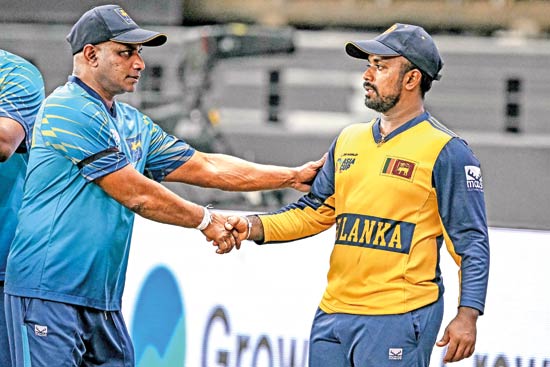Sri Lanka, the phoenix incapable of rising from the ashes in T20
On paper, this is as strong as a squad Sri Lanka can field. A few others are waiting in the wings, but whether they can move from local dominance to global impact is a gamble. The big gap between promise and performance continues to haunt the team. Chamika Karunaratne, for example, was outstanding in the domestic T20, but whether he can replicate that at international level is still uncertain. And he is not alone.

The firsts to receive blame when the side underperform are the coach and the captain - AFP
The Asia Cup didn’t reveal anything new. One day, Sri Lanka are thrilling. The next, they are fragile. Against India in the last game, with no pressure and nothing at stake, they played with freedom, only to fall short again. The batting is brittle, the middle order unreliable, selections unsettled. It has been the same story over the years. The real question is not how they lost in Dubai, but how they plan to stop repeating the same mistakes at next year’s T20 World Cup. Hope, without planning, has carried this team for too long.
Right now, some players are not just trying to score runs, they are trying to save their places. That sort of insecurity kills confidence. And in T20 cricket, hesitation is fatal. Chopping and changing the squad at this stage makes little sense. Roles must be defined. Players must be trusted and given time to grow. Who anchors, who attacks, who finishes–these answers should be settled long before a tournament begins, not while the game is in progress.
But tactics are not the biggest issue. Resilience is. Under pressure, Sri Lanka crack. It happened again against India on Friday night. Chasing 203, they were in control but froze at the finish, handing India the game in a Super Over. These collapses are not about unplayable deliveries. They are about panic. Other nations put serious work into mental conditioning, preparing players to absorb pressure. Sri Lanka still believe that raw talent is enough. But talent without mental steel is fragile. It burns bright and then fades at the first sign of strain.
Chief Selector Upul Tharanga put it plainly: “Too often, when the pressure builds, the players seem lost. The only way forward is for them to take responsibility, read situations, and adapt.”
The batting problems go beyond fragility. They also show a lack of game awareness. Power-hitting has never been Sri Lanka’s strength, but totals of 170 or 180 are still within reach with smart rotation, fitness, and finding gaps. Instead, the middle overs often drift into wasted deliveries, and momentum disappears. This is about intent, not magic six-hitters. As Tharanga said: “T20 cricket is not only about sixes and fours. It is about rotating strike, running hard, and knowing your strengths.”
Bowling has been better, with Wanindu Hasaranga still as the big match-winner and the fast bowlers showing glimpses. But the balance is missing. Big tournaments demand flexibility, not predictability. And the lack of genuine all-rounders is glaring. Sri Lanka once thrived on players who could blur the lines, batters who bowled and bowlers who fought with the bat. That balance is gone, leaving the team rigid and one-dimensional.
The Board now faces a choice. They could do what they always do: swing the axe, bring in new faces, and promise a fresh start. But that cycle of panic changes and empty talk is why Sri Lanka keep stumbling. What the players need is stability. Senior players, in particular, cannot keep hiding. Their performances set the standard, and too often they have left the younger ones to carry the weight.
Tharanga’s words cut to the core: “This squad is talented, but talent alone is not enough. One day they score 200. And on another, they collapse for 100. That inconsistency is the problem. We must back this group and fix specific areas instead of chopping and changing.”
The World Cup in the subcontinent is a chance for redemption. The pitches will suit Sri Lanka, the fans will back them. But that support can quickly turn into pressure if the same flaws continue. Belief does not come from slogans. It comes from preparation, discipline and execution. Lessons mean nothing if they are never applied.
“There is no shortage of effort,” Tharanga added.
“But the problem is execution. They train hard and plan well, but do not deliver when it matters. The players must take responsibility.”
There is enough talent in this side to compete with any team in the world. But talent on its own has never been enough. What Sri Lanka need now is discipline, planning and mental toughness. If they build those qualities in the months ahead, the World Cup could be a turning point. If not, and if scapegoating and panic fixes return, this Asia Cup will simply become another chapter in a long, painful decline.


